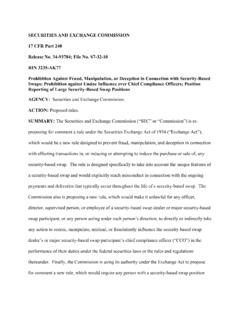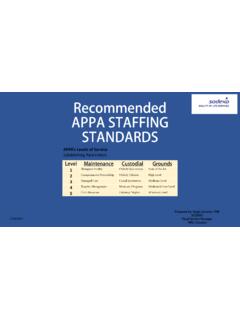Transcription of Senate Confirmation Process: A Brief Overview
1 CRS Report for CongressPrepared for Members and Committees of Congress Senate Confirmation Process: A Brief Overview Lorraine H. Tong Analyst in American National Government July 20, 2009 Congressional Research Service7-5700 RS20986 Senate Confirmation Process: A Brief Overview Congressional Research Service Summary The role of the Senate in the Confirmation process is defined in the Constitution. Article II, Section 2 provides that the President shall nominate, and by and with the Advice and Consent of the Senate , shall appoint high government officials. Positions requiring Confirmation are specified by statute. Senate Rule XXXI regulates proceedings on nominations in executive sessions ( executive in this case refers to executive business, not to a closed or secret session).
2 Each Senate committee may adopt its own procedures as long as they do not conflict with Senate rules. For more information on congressional processes, see Senate Confirmation Process: A Brief Overview Congressional Research Service Contents Presidential Submission .. 1 Committee Referral and 1 Floor Consideration .. 2 White House 2 Routine Nominations .. 2 Contacts Author Contact Information .. 3 Senate Confirmation Process: A Brief Overview Congressional Research Service 1 he role of the Senate in the Confirmation process is defined in the Constitution. Article II, Section 2 provides that the President shall nominate, and by and with the Advice and Consent of the Senate , shall appoint high government officials. Positions requiring Confirmation are specified by statute.
3 Senate Rule XXXI regulates proceedings on nominations in executive sessions ( executive in this case refers to executive business, not to a closed or secret session). Each Senate committee may adopt its own procedures as long as they do not conflict with Senate rules. For more information on congressional processes, see The Senate gives its advice and consent to presidential appointments to the Supreme Court1 and to high-level positions in the Cabinet departments and independent agencies. The Senate also confirms appointments of members of regulatory commissions, ambassadors, federal judges, attorneys, and marshals. There are more than 2,000 of these appointments as well as thousands of routine non-political appointments and promotions in the military and other civilian positions that require Appointees named to be Supreme Court justices and Cabinet secretaries receive the Senate s closest scrutiny due to the significance of these positions.
4 Approximately 99% of all presidential appointments are approved. The Confirmation process for individual nominations typically follows these steps: Presidential Submission The President submits a nomination in writing to the Senate . The nomination is read on the floor and the executive clerk assigns it a number. A nomination is not voted on by the full Senate on the same day the Senate receives it, or on the day on which it is reported by a committee, except by unanimous consent. Committee Referral and Consideration The Parliamentarian, acting on behalf of the presiding officer, refers each nomination to the committee with jurisdiction over the position or the agency in which the position exists. More than one committee may have the opportunity to examine a nomination; some nominations are referred sequentially, and a few are jointly referred to two or more committees.
5 Confirmation hearings, generally open to the public, are not held on all nominations. The closest scrutiny in hearings is given to the most senior appointments, and also to controversial nominees, to afford committee members an opportunity to question a nominee to determine his or her fitness for a post. Senators may also use hearings as a forum to advance their own views on public policy, to determine or challenge the administration s position on policy issues, and to extract commitments from a nominee. In addition to investigations already conducted by or at the behest of the White House, each Senate committee may have its own questions or forms for the nominee, and may conduct its own investigation. Often a nominee is introduced at a hearing by a Senator or both Senators from his or her home state, and may be accompanied by other Members of Congress.
6 Supporters and opponents of a nominee are occasionally permitted to testify. 1 CRS reports on Supreme Court and other judicial appointments are available at 2 CRS reports on Executive Branch appointments are available at T Senate Confirmation Process: A Brief Overview Congressional Research Service 2 Most committees have rules governing how soon after hearings the committee may vote on a nomination. The committee has the option to report the nomination favorably, unfavorably, or without recommendation, or to take no action at all. If the committee votes to report the nomination, it is then filed with the legislative clerk, who notifies the executive clerk. Committees usually do not submit written reports to accompany nominations.
7 The executive clerk assigns a calendar number to each reported nomination (or list of nominees in the case of military commissions), and the nomination is placed on the Executive Calendar. The calendar identifies the number of the presidential nomination message, the name of the nominee, the office to which he or she is nominated, and the name of the predecessor holding the office. Other details about the nomination, such as committee action, are also provided. Although unusual a committee may be discharged by resolution from further consideration of a nomination. Such a resolution is listed in the Executive Calendar. Floor Consideration The Senate meets in executive session to consider nominations, but may not begin floor consideration of a nomination until it has been on the Executive Calendar for at least one day, except by unanimous consent.
8 Nominations are subject to unlimited debate, subject to cloture being invoked (which requires 60 votes). In some instances, one or more Senators may place a hold on a nomination, thereby delaying or preventing it from reaching the floor for further action. Under Senate Rule XXXI, the final question on a nomination is, Will the Senate advise and consent to this nomination? The Senate has three options: confirm, reject, or take no action on the nomination. Confirmation requires a simple majority vote. Although Senate Rule XXXI requires pending nominations be returned to the President when the Senate recesses for more than 30 days or adjourns between sessions, this requirement is often waived. Nominations pending at the end of a Congress are returned to the President, and they must be resubmitted for the Senate to reconsider them.
9 White House Notification Once the Senate has acted on a nomination, the Secretary of the Senate attests to a resolution of Confirmation or rejection, which is transmitted to the White House. All nominations submitted to the Senate as well as action on them are printed in the Congressional Record and a number of other Senate publications. Details on nominations pending, confirmed, withdrawn, failed, and returned are available at Routine Nominations The Senate also confirms nonpolitical appointments to and promotions in the military and other civilian positions (in the Foreign Service, Public Health Service, and National Oceanic Atmospheric Administration). These routine nominations are usually placed on the secretary s desk. The Senate typically considers and approves these nominations by unanimous consent, frequently en bloc, without committee action.
10 Routine nominations in any given Congress number between 50,000 and 100,000. Senate Confirmation Process: A Brief Overview Congressional Research Service 3 Author Contact Information Lorraine H. Tong Analyst in American National Government 7-5846

















